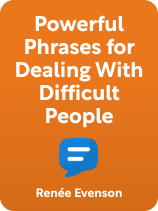

This article is an excerpt from the Shortform book guide to "Powerful Phrases for Dealing With Difficult People" by Renee Evenson. Shortform has the world's best summaries and analyses of books you should be reading.
Like this article? Sign up for a free trial here.
Do you struggle to communicate with difficult people? What if you had the tools to handle challenging interactions more effectively?
In Powerful Phrases for Dealing with Difficult People, business consultant Renée Evenson offers practical advice for improving relationships through better communication. She outlines a five-stage process for resolving conflicts and creating more cooperative environments, personally and professionally.
Read on to discover how you can transform your challenging relationships and become a master of conflict resolution.
Overview of Powerful Phrases for Dealing with Difficult People
Is there someone in your life who always pushes your buttons? Someone who makes the simplest interaction feel like pulling teeth? In Powerful Phrases for Dealing with Difficult People, business training consultant Renée Evenson argues that you can reform your relationships with difficult people with the right conversational skills. By mastering the art of effective communication, you can avoid frustrating conflicts, create a more cooperative working environment, and accomplish more in your personal and professional lives.
Evenson is a business training consultant specializing in conflict resolution and customer service. Before becoming a writer, she worked for 15 years at BellSouth Telecommunications (now part of AT&T), where she facilitated customer service for small business accounts and created training materials for employee development. Evenson has written a number of other books, including Powerful Phrases for Effective Customer Service and Customer Service Training 101, both of which extend Evenson’s principles of empathy-centered communication to customer service.
We’ll begin by explaining why conflict resolution skills are so necessary. Then, we’ll break down Evenson’s five-part process of conflict resolution, detailing how to confront people about their difficult behavior in a way that leaves everyone happy.
(Shortform note: Evenson says that some conflicts involve more than two people, but for simplicity’s sake, we’ve described her conflict resolution process in the context of one-on-one conflict resolutions. All the following advice applies equally well if more than two people are involved in conflict resolution.)
Why Conflict Resolution Skills Are Necessary
Evenson asserts that conflict is an inevitable part of life. At some point, someone you see regularly is going to get in the habit of doing something you find harmful, annoying, or unproductive, and you’re going to want them to stop. This is particularly common at work: Whereas you can choose your friends, you don’t choose your co-workers. You’re stuck with whoever’s there.
According to Evenson, mature conflict resolution is necessary to maintain collaborative relationships. When two people openly discuss a conflict in a way that demonstrates mutual respect, it helps them realize they can trust each other to help meet each other’s needs. In this way, conflicts can leave relationships stronger than before.
The skills required to responsibly resolve conflicts and maintain productive working relationships are rare, so they’re a great way to distinguish yourself as a uniquely valuable employee. Evenson points out that employees with excellent interpersonal skills are often promoted over those who may have superior technical knowledge or job-specific skills.
The Downsides of Avoiding Conflict
According to Evenson, one major reason that conflict resolution skills are important is that avoiding conflict often ends in disaster. Most people shy away from conflict because it’s uncomfortable. However, if you try to ignore a problem and pretend you’re unbothered by it, your frustration and other negative emotions will only grow stronger. This will make the relationship increasingly strained and dysfunctional as time goes on.
Additionally, Evenson contends that your pent-up feelings may eventually become uncontainable, and you’ll rant at the other person in a way that’s inappropriately intense. This kind of outburst can permanently sour a relationship.
We’ve established that proper conflict resolution is a necessary part of any healthy relationship—at work or otherwise. Evenson divides the process of conflict resolution into five stages:
- Stage #1: Plan How You’ll Resolve the Conflict
- Stage #2: Establish Mutual Empathy
- Stage #3: Clarify the Issue at Hand
- Stage #4: Suggest a Potential Fix
- Stage #5: Make a Final Decision
We’ll discuss each stage in turn.
Stage #1: Plan How You’ll Resolve the Conflict
Evenson explains that conflicts of any kind are often emotionally charged—it’s natural to feel hurt, angry, or defensive if you believe someone has wronged you. However, if you confront the other person while strongly feeling these emotions, you’re likely to escalate the situation, triggering intense emotional reactions. Thus, the two of you will be less likely to cooperate and look for a mutually satisfying resolution.
Instead, when you first realize that conflict resolution is necessary, take some time to calm down, analyze the situation rationally, and make a plan before talking to the other person.
We’ll explain why empathy is vital when planning for conflict resolution. Then, we’ll describe how to mentally rehearse for conflict resolution. We’ll also cover what to do if someone surprises you with a confrontation and you don’t have time to plan.
Practice Empathy While Planning
Evenson recommends that during this planning time, you should re-examine the situation from the other person’s point of view. It’s easy to assume that someone has deliberately wronged you or is being unreasonable, but this isn’t always the case. If you consider alternative explanations, you may realize that the conflict is the result of a misunderstanding, and they had valid reasons to act how they did. Empathizing with the other person will help you remain calm and solution-oriented during the conflict resolution.
For example, imagine you discover that your co-worker scheduled a meeting with your entire team without you. Initially, you feel enraged because you assume that they intentionally excluded you, knowing that you’d disagree with their strategy proposal. However, after imagining the situation from their perspective, you realize that you mentioned you needed to concentrate on uninterrupted work this week. They were probably excluding you out of courtesy. This helps you approach your co-worker from a place of calm and understanding.
Mentally Rehearse the Conflict Resolution
Evenson notes that in addition to preparing emotionally, you should plan whatever practical details of the conflict resolution you can. Think through the points you want to make and anticipate the other person’s potential reactions. Mentally rehearsing a calm and constructive conflict resolution will make it easier to act that way during the conversation.
How to Plan After Someone Confronts You
Evenson warns that taking time to reflect on the situation can be particularly difficult if someone surprises you with a confrontation. This can happen if you’ve offended someone without realizing it. When someone angrily confronts you, you’ll likely feel defensive: You’ll want to immediately deny their accusations and make some of your own to get even.
Instead, try your best to stay calm. Let the other person get everything off their chest before speaking—interrupting them will only frustrate them further. Furthermore, show the other person that you’re genuinely listening: They’ll be more likely to cooperate if it seems like you understand their grievances and empathize with them.
Stage #2: Establish Mutual Empathy
When you initiate conflict resolution, try to establish an empathetic connection as soon as possible. Evenson argues that to have a productive discussion, you need to understand how the other person sees the conflict and get them to understand how you see it.
The key is to avoid making the other person feel defensive: If someone feels like you’re attacking, accusing, or blaming them, they’ll focus on protecting themselves by trying to “win” the fight. They’ll attack, accuse, and blame you instead of working toward a solution.
We’re going to discuss a few ways to build empathetic connections and avoid triggering defensiveness: Focus on expressing your feelings, ask about the other person’s point of view, state your desire for compromise, and use constructive nonverbal signals.
Begin by Stating Your Feelings
Evenson recommends beginning every conflict resolution with “I” messages: statements starting with “I” that express how the situation at hand impacted your feelings. For instance, “I felt offended when you minimized the importance of my team’s project at today’s meeting” and “I’m scared that customers will get upset if you use that kind of language in front of them” would be “I” messages. “I” messages allow you to bring up the problem without making it seem like you’re attacking, accusing, or blaming the other person.
In contrast, when most people start a confrontation, they instinctively resort to “you” messages: statements starting with “you” that frame the problem as the other person’s fault. For example, “You were being incredibly disrespectful in today’s meeting” and “You need to control yourself in front of the customers” would be “you” messages. “You” messages tend to make the other person defensive, escalating the conflict.
Ask About and Express the Other Person’s Point of View
After you express your feelings with an “I” message, ask objective, non-judgmental questions to encourage the other person to share their thoughts and feelings about the conflict. Evenson contends that when you seek to understand the other person’s perspective, you establish a tone of mutual respect and collaboration that will make it much easier to discover solutions.
While the other person explains how they see the situation, practice active listening: Use affirmative sounds like “ahh,” or “mhmm” to show that you understand what they’re saying. If you get confused at any point, use sounds like “hmm?” or “oh?” to let the other person know they need to clarify something.
Furthermore, Evenson asserts that throughout your conversation, you should express the other person’s point of view. For example, you might say “I see how it would be frustrating to have me micromanaging your work like that,” or “You’ve probably felt pretty powerless since I took that project off your plate.” Ideally, this will prove to the other person that you want to find a solution that benefits them, and they’ll be more likely to cooperate. Verbally empathizing in this way can also inspire them to see the situation from your point of view.
Commit to Finding a Compromise
Evenson recommends directly stating throughout the conflict resolution process that you want to find a mutually acceptable compromise. This way, you repeatedly remind the other person that your goal is to negotiate in good faith rather than “win” the conflict by proving they’re in the wrong.
Anytime you need to defuse defensive reactions or refocus the dialogue on problem-solving, reaffirm your commitment to compromise. For example, you might say something like “Let’s talk this out and see if we can understand where each other is coming from,” or “I’m trying to find a solution that works for both of us.”
Use Calm, Confident, and Empathetic Nonverbal Signals
Evenson explains that although the words you use are important, your body language, facial expressions, and tone of voice communicate your true feelings more directly. For this reason, send nonverbal signals that show the other person you’re calm, empathetic, and confident. Seeming calm and empathetic will keep the other person from getting defensive, and showing confidence will make them more likely to respect your desires and see your suggested solutions as valuable.
Evenson recommends using these nonverbal signals to have the most productive conflict resolution:
- Sit or stand upright to appear confident—but at the same time, stay loose and relaxed to appear calm.
- Maintain a kind, caring facial expression, even if you don’t feel kind or caring.
- Keep eye contact that’s strong, but not so strong that it makes the other person uncomfortable.
- Speak quietly and slowly rather than forcefully.
At first, you may feel like you’re awkwardly forcing yourself to perform these nonverbal signals, but over time, they’ll become instinctive and authentic.
Stage #3: Clarify the Issue at Hand
According to Evenson, once you clearly understand both sides of the conflict, it’s time to clarify the issue at the heart of the conflict. It’s impossible to brainstorm solutions until you agree on what you’re trying to resolve. To do this, restate the issue from your point of view and ask the other person to do the same. If you’re not on the same page, return to Stage #2 and ask questions to better understand their perspective.
For example, imagine you’re a manager who’s recently equipped your team with a new project management software. However, one of your workers repeatedly fails to update the status of their tasks on this software. You tell them that you assume the issue is that they don’t have the time to learn the software. However, the worker explains that they think the real issue is that the spreadsheet-based system the team used before was more effective than this new software. Thus, you realize there’s a gap in your understanding and return to Stage #2, asking why the worker believes the old system was better.
If They Refuse to Budge, Apologize
Evenson notes that, if the other person clings to their point of view and stubbornly refuses to consider any other way of seeing the issue, it may help for you to offer a heartfelt apology. By apologizing, you show deference to the other person and appeal to their sense of empathy, transforming the tone of a conversation. An apology can disarm hostility and defensiveness, lessen ego on both sides, and move a stuck dialogue forward.
Evenson clarifies that apologizing doesn’t necessarily mean admitting that you’re at fault. Instead, it just means that you’re willing to take responsibility for finding a solution and repairing the damaged relationship, if necessary.
You can apologize for any number of things, as long as it’s genuine and relevant to the conflict. For instance, you might say something like “I’d like to apologize for not realizing sooner that you felt so left out,” or “Sorry for bringing up this awkward issue, but I think we need to sort it out.”
Stage #4: Suggest a Potential Fix
Evenson explains that, after you’ve agreed on the precise issue you need to resolve, it’s time to suggest a potential fix and encourage the other person to do the same. The goal of this stage is to arrive at a solution collaboratively: Suggest the best possible solution you can think of, and then actively listen to the other person’s input. When they propose a solution, evaluate it objectively and with an open mind.
At this stage, it’s especially important to emphasize your desire for compromise to the other person. If they ever try to blame you or argue about who’s right or wrong, remind them that you just want to find a solution you can both agree on. Hopefully, this will keep the discussion on track. According to Evenson, any solution you propose that clearly takes the other person’s needs into account will make them less likely to get defensive or uncooperative.
If the Discussion Gets Too Intense, Take a Break
According to Evenson, if your discussion becomes heated and unproductive, consider halting the meeting temporarily to give both of you time to cool off. After you’ve both had time to think through the situation alone, it may be easier to negotiate solutions the next time you discuss it.
Stage #5: Make a Final Decision
Evenson states that, after both sides have proposed potential fixes, the last thing to do is definitively decide how to resolve the issue. Ideally, someone will propose a solution that both parties gladly accept, ending the conflict.
Let’s discuss two important steps of ending a conflict: Confirming a decision and affirming the relationship. Additionally, we’ll discuss what to do if it’s impossible to agree on a solution.
Confirm Your Decision
Evenson suggests that once you’ve identified a solution that makes both of you happy, repeat it to ensure the other person fully understands and accepts it. For instance, say something like, “Great. I’ll stop emailing you asking for updates if you meet with me every Monday to review your team’s progress.” This added clarity helps prevent misunderstandings and future conflicts.
Affirm the Relationship
Finally, Evenson recommends ending your conversation by expressing how happy you are that you were able to come to an agreement and how much you appreciate your relationship with the other person. For instance, you might say, “I’m happy we could work this out! I’m excited to see what we’ll be able to accomplish together next.”
This kind of conclusion leaves a lasting positive impression on the other person and makes them feel a stronger bond with you.
Sometimes, You Have to Give Up
Evenson notes that, in situations where the two of you are unable to communicate effectively or find a mutually acceptable agreement, you may have to give up on achieving a win-win outcome. In this case, it’s important to still affirm the relationship. This helps you maintain a collaborative relationship even if you can’t see eye to eye on this particular issue. Say something like, “It’s too bad we couldn’t settle this disagreement, but I’m sure we’ll still be able to do great work together.”
If you don’t have the authority to resolve the issue without the other person’s help, you may need to simply accept things as they are and get used to it. Alternatively, in the workplace, you could present your case to someone in a position of authority and get them to intervene. Evenson asserts that this should be a last resort—leaving the person you disagree with out of the conversation might damage your relationship with them.
On the other hand, it’s possible that you have the authority to resolve the issue in a way you believe is best, but that the other person doesn’t like. In this case, Evenson recommends respectfully explaining the reasoning behind your final decision to the other person. This way, even if they disagree, they’ll have more respect for your decision-making process. This will leave them more likely to make peace with your decision and maintain a strong relationship with you.
For example, imagine you’re the founder of a startup. After a deep discussion, you decide to move forward with a certain marketing strategy, even though your COO believes it’s suboptimal. You explain that although they raise valid concerns, preliminary research shows that the marketing strategy would be successful, so you’re going to try it out for a couple of months. This reasoned explanation motivates the COO to respect your leadership and continue doing their best work for the company, even if they still think your marketing strategy is a mistake.

———End of Preview———
Like what you just read? Read the rest of the world's best book summary and analysis of Renee Evenson's "Powerful Phrases for Dealing With Difficult People" at Shortform.
Here's what you'll find in our full Powerful Phrases for Dealing With Difficult People summary:
- The downsides of avoiding conflict
- How to keep people from getting defensive
- What to do before you attempt conflict resolution






